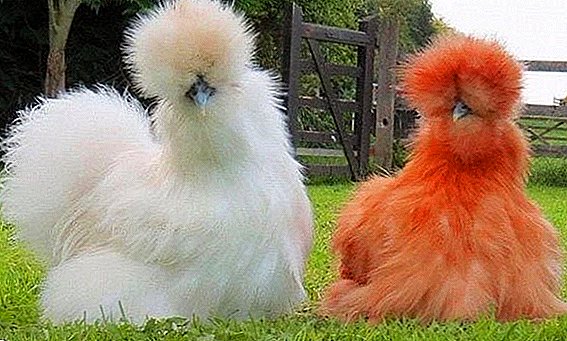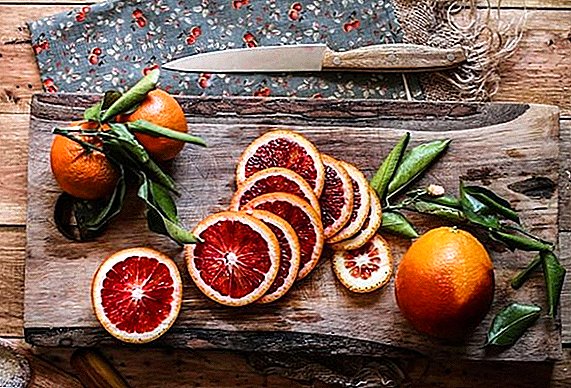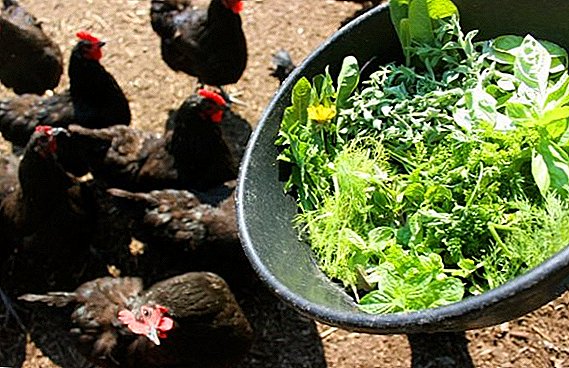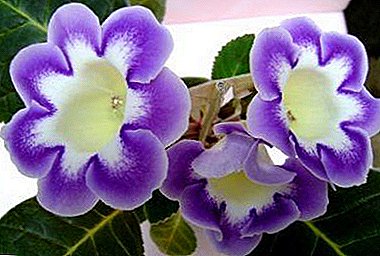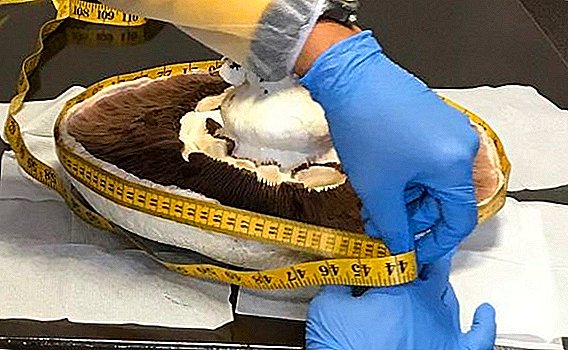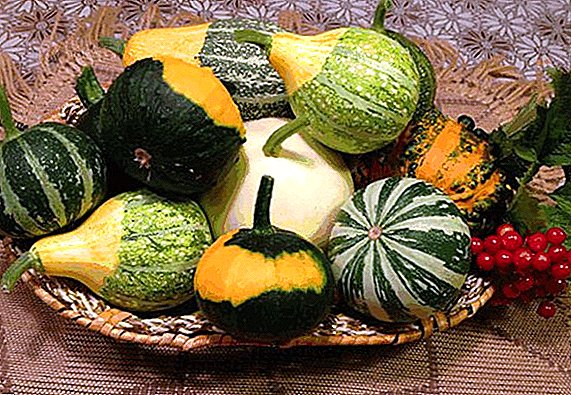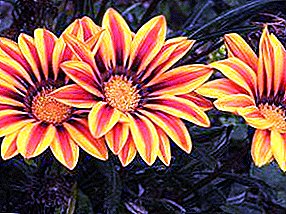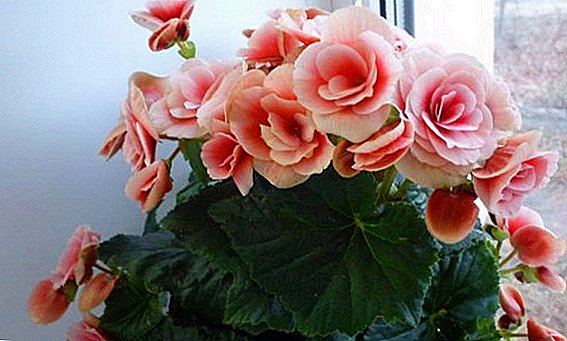 Among the representatives of indoor plants, one of the most charming and beautiful flowers is considered to be a hybrid begonia elatior.
Among the representatives of indoor plants, one of the most charming and beautiful flowers is considered to be a hybrid begonia elatior.
She is able to please flower growers with luxurious blooms twice a year and with a wonderful aesthetic look.
Since the plant can give flowers not only in summer but also in winter, it is also called overwintering begonia.
Description
Begonia Elatior is a flowering indoor culture, obtained by breeding two types of begonias: Socotrans and tuber. A feature of the hybrid is its incredibly lush flowering, in which up to 70 flowers can appear simultaneously.  The flowers are small, lush, have a bright color: from pale beige to rich red.
The flowers are small, lush, have a bright color: from pale beige to rich red.
Begonia has shiny succulent leaves up to 8 cm long with a serrate edge, an upright fleshy stem. The leaf plate is dense, glossy, two-color: saturated green color prevails on top, light green with clear veins from below. The height of the flower reaches 40 cm.
You will also be interested to learn about the cultivation of such types of begonias as coral, bolivian, ampelous, royal, tuberous begonia.
This hybrid of begonias differs from its sisters by a long flowering time. The buds that appeared in August bloom for six months, before the onset of winter.
The color and structure of the flowers are different: they can be double or regular, beige, white or saturated wine shades. The shade of the petals and the shape of the corolla depend on the type of culture. 
Kinds
There are several types of begonia elatior, but they are all divided into tall (grows up to 40 cm), sredneroslye (height from 30 cm) and undersized (below 30 cm).
The most popular types are:
- Baladin has a lush flowering and multi-tiered flowers, the number of which can reach 70 units. The plant grows up to 30 cm. The peculiarity of the species is the abundance of flowers of different colors: on one bush there can be up to three shades of petals - from white to wine red. Thanks to this variety of colors, Baladin is often used as a bouquet in a pot;

Did you know? Hybrid Baladin nicknamed "touchy." The fact is that if you touch its petals, then the skin will have spots of a characteristic rusty-brown color.
- Borias - a compact flower, bred in England. Differs in small size, long flowering period. On the bush can grow as ordinary flowers, and terry, located on a multi-tiered inflorescence. Petals have a pink color with a thin white edging. In most cases, Borias is used for interior decoration;

- Grace originally from Southeast Asia. Begonia of this species is famous for its lush, loose inflorescence with red flowers and bright green leaves with well-marked veins. The bush blossoms once a year for three months.

Features of growing
Elatior is a tender, beautiful, whimsical care plant with abundant flowering, which is why it is often used to decorate home interiors, decorating private houses and offices.
As an ornamental houseplant use such as indoor vine, ripsalis, xanthosoma, zephyranthes, aihrizone, fittonia mix, columney, cryptomeria, syngonium, aechmea.
However, before you grow a flower yourself, you need to know a few important features.
Begonia has delicate, small and fragile roots, so a small pot is required to plant it. The soil is suitable loose and nutritious, able to retain moisture, but at the same time it dries well.
It is better to select the soil for transplanting yourself, for this purpose they are taken in equal proportions: peat, humus and leaf earth. Gardeners also recommend adding some river sand, vermiculite and perlite to the substrate. 
Important! Newly acquired begonia requires transplantation, but you need to wish it not immediately, but weeks and a half after its appearance in your home. If the plant is just in the flowering period, then you should wait for its completion.
The first time the acquired hybrid will adapt to home conditions. During this period, it is necessary to remove the old foliage and flowers, as well as to carry out the treatment with a fungicide, for example, "Fitosporin", which will exclude the effect of pathogenic bacteria and microorganisms on weakened begonia.
Elatior belongs to the light-loving flowers that you need to remember when choosing a place for it. With insufficient light, the crown will lose its luster, and the buds will eventually fall off.
It is very important for the plant to observe harmony in the light, because too bright light also negatively affects the state: double flowers reduce fluffiness, and petals fade.  For the residence of the hybrid window sills are perfectly suited to the west or east. Elatior - culture of short daylight, therefore, does not require additional lighting in winter. It is also necessary to remember that the place for the flower must be permanent, otherwise it will begin to reset the buds.
For the residence of the hybrid window sills are perfectly suited to the west or east. Elatior - culture of short daylight, therefore, does not require additional lighting in winter. It is also necessary to remember that the place for the flower must be permanent, otherwise it will begin to reset the buds.
Even minor deviations in temperature adversely affect the flower. When the temperature drops, it slows down its growth, losing some of its leafy cover.
In addition, low temperature contributes to the development of pathogenic bacteria and fungi, which can lead to infection with various diseases. The lower limit of temperature - from +8 to +10 degrees, with a decrease in the level of the flower dies. Optimal support indoors + 22 ... +25 degrees.
Hybrid loves high humidity. It is not recommended to spray the flowers from above, because they lose their luster and aesthetics, and evaporation of water from the surface causes burns of the leaves.  In order to create the necessary moisture, you need to put the pot with begonia in a pan filled with absorbent material, which is used as expanded clay or peat.
In order to create the necessary moisture, you need to put the pot with begonia in a pan filled with absorbent material, which is used as expanded clay or peat.
Since the root system of an exotic culture is poorly developed, the following rule should be followed when choosing a container for it: the diameter of the pot and its height should be identical. Thus, the plant is perfectly suited for a wide, shallow capacity.
It is also necessary to ensure a sufficient number of wide drainage holes that will not allow the soil to clump up and rot.
To watering a hybrid needs a special approach. In this case, it is better not to pour out, rather than pour. Excessive water leads to rotting of the root system, and, as a result, the death of the flower. When irrigating experienced growers advise the method of immersion. For irrigation, separated water at room temperature is suitable. 
Care
Since the elatio is a fragile, tender plant, it requires proper care. Culture is susceptible to stressful situations, transportation, temperature extremes, poor conditions.
Competent care for the flower includes, above all, fertilizing. As fertilizers, it is better to use complex mineral fertilizers, for example, Kemira-Lux, specially designed for ornamental plants.
Important! Organic fertilizers are not recommended because they are saturated with nitrogen, which leads to deterioration of the cuttings, stems and flowers - they become weak, sluggish and very fragile.Minerals feed the hybrid every week, taking half the required dose. Several times during flowering, potash supplements are introduced, which contribute to the proper germination of flowers.
To potassium fertilizers include such as "Kalimag", "Kalimagneziya."
 Perennial quickly grows old, so it must be regularly cut and pinch the top.
Perennial quickly grows old, so it must be regularly cut and pinch the top.During pruning, old leaves are removed, withered corollas, lower processes that interfere with the normal ventilation of the root part. The first time the plant is pruned, when they reach a height of about 7 cm.
Shrubs give the desired shape, and then reduce watering until, until the intensive growth begins. When the shoots reach 12 cm, they are pruned again from the side and from above.
It is not recommended to use scissors as a tool for cutting, as they can damage the plant, it is better to use a sharp knife.
From November to March, the begonia is at rest. In order to properly prepare it for wintering, watering should be reduced. After the green part of the culture fades, it must be removed and the flower moved to a cool place until spring.  At rest, the hybrid does not feed and provide poor watering. With the onset of spring, rejuvenating pruning is carried out - the stems are cut at a height of 7-8 cm, and fed with growth stimulants, for example, "Epine".
At rest, the hybrid does not feed and provide poor watering. With the onset of spring, rejuvenating pruning is carried out - the stems are cut at a height of 7-8 cm, and fed with growth stimulants, for example, "Epine".
Diseases
Begonia that does not receive the necessary care begins to ache and may eventually die.
The reasons that lead to flower diseases can be:
- insufficient moisture and poor watering, as a result, the plant drops foliage and flowers;
- lack of lighting, which leads to the paleness of the leaves and the loss of their luster;
- an increased level of humidity, which provokes the appearance of mold on the buds.
 Elatior is most often prone to fungal diseases, especially powdery mildew. Beneficial conditions for this disease are low humidity and sudden temperature fluctuations.
Elatior is most often prone to fungal diseases, especially powdery mildew. Beneficial conditions for this disease are low humidity and sudden temperature fluctuations.White deposits on leaves and buds are the first signs of powdery mildew. For treatment, the plant is treated with a special fungicide or soap and vitriol solution. For the preparation of the last in 1 liter of water, dilute 2 g of vitriol and 20 g of soap.
It will also be helpful for you to learn how to deal with powdery mildew, aphids and spider mites.
In home conditions, a hybrid can infect aphid or spider mite. If there are not too many parasites, it is necessary to treat the leaves and stems with soapy water. With a strong defeat of the flower, use the drugs "Karbofos" or "Intavir".
The presence of watery spots on the leaves, after which they deteriorate and turn black, may indicate the development of bacterial blotch. To combat it, copper oxychloride 5% is used. The treatment is repeated after 14 days.  A white, watery bloom on the tops of the plant, which later turns into brown rot, indicates the development of gray rot that appears as a result of exposure to the botrytis fungus.
A white, watery bloom on the tops of the plant, which later turns into brown rot, indicates the development of gray rot that appears as a result of exposure to the botrytis fungus.
To get rid of the disease, apply vitriol-soap solution: 40 grams of soap and 2 grams of copper vitriol are added to 1 liter of water.
Breeding methods
After the end of the winter period, the culture is transplanted. The procedure should be repeated every 2-3 years, as the root system of the flower grows and requires more space. Before planting, the roots shake off the ground and put for 1 hour in a weak solution of potassium permanganate.
Remove weak and rotten roots, plant an elater in a new pot, which is 3 cm more than the previous one. After transplanting the flower is watered regularly. 
Did you know? Begonia was discovered at the end of the 17th century by a French expedition to Haiti. The flower was named after the head of the expedition Michel Begon.
Reproduction begonias carried out in two ways: cuttings and seeds. The breeding of begonias with cuttings is carried out in the spring or early summer.
For this:
- On the bush choose the most powerful, strong and large leaves.
- The leaves are planted in special substrates, obtained by mixing one part of peat and three parts of sand.
- Tarau leaves are transferred to a dark place for about 2 months to sprout.
- For disembarkation take a shoot not less than 5 cm. At planting the leaf should not adjoin to a ground.
Reproduction by cuttings from the stem is carried out by a similar algorithm. For planting choose stems from 7 cm. They are planted immediately after cutting.  Growing a plant from seed is a rather troublesome process. Since all types of Elaitor begonias are hybrids, it is very difficult to collect material for reproduction from a flower. Planting seeds begin in February and March.
Growing a plant from seed is a rather troublesome process. Since all types of Elaitor begonias are hybrids, it is very difficult to collect material for reproduction from a flower. Planting seeds begin in February and March.
To do this, pour out the seeds from the package and mix them with sand. The prepared material is sown in a special soil. The soil is prepared as follows: peat, sand and earth are mixed in a 1: 1: 2 ratio.
The mixture is poured into a container, which is placed on a tray with warm water. When the soil collects the required amount of water and cools to room temperature, seeds are planted with sand in it.
After sowing, the soil is irrigated with a spray gun, the container is covered with glass or film, the temperature is maintained at about + 22 ... +25 degrees, provide 14-hour lighting.  When properly planted in about one month sprouts will appear. No later than 7 days, they are transplanted into a separate small container, for example, cups, and after a few more months - into the necessary container.
When properly planted in about one month sprouts will appear. No later than 7 days, they are transplanted into a separate small container, for example, cups, and after a few more months - into the necessary container.
Begonia Elatior is a unique, decorative culture, characterized by lush abundant flowering and high aesthetic indicators.
Despite certain difficulties in the maintenance of the flower, subject to the basic rules of caring for it, you can get a room decoration that will delight its owners with an amazing view over the years.
Feedback from network users
In one place I read this about this begonia: it continuously blooms for 6–8 months in a row (it releases new twigs with new buds). and then completely, completely ceases to bloom (like growing up). then it must be drafted and a new plant grown from a cutting.but
//homeflowers.ru/yabbse/index.php?showtopic=7526&p=114643
When she tried to be extremely careful, they easily got out of the pot and I transplanted them to a new one. But I’m still worried about the size of the pots ... are they really big? ... I thought that it was a bush plant ... and it grows in the open field, that we need rather big pots. On the other hand, I understand perfectly that flowering plants should grow in pots that are not very large in order for them to bloom. And her roots are very small and woven.Tsvyatochek
//forum.bestflowers.ru/t/begonija-gibridnaja-ehlatior-b-hybrida-elatior-ili-begonija-zimnjaja.138399/#post-165481
This begonia is very beautiful, but fastidious. Stalk, by the way, can quickly bloom. And when your begonia grows, take a cutting and rooting from it, as it may bloom and disappear. Good luck! And yet, it blooms all year round, but does not like the heat.Ludovika
//www.flowers-house.ru/showthread.php?t=9217&s=fedd51566e951873f3c63fecac28c21b&p=187263&viewfull=1#post187263


